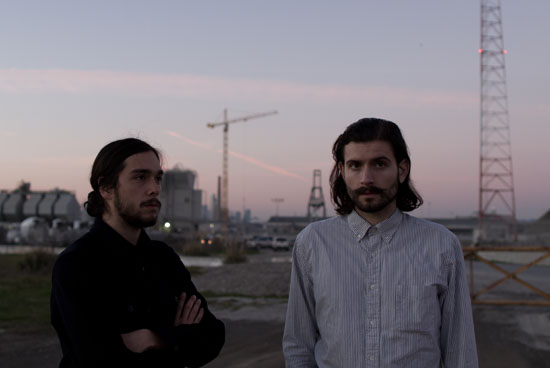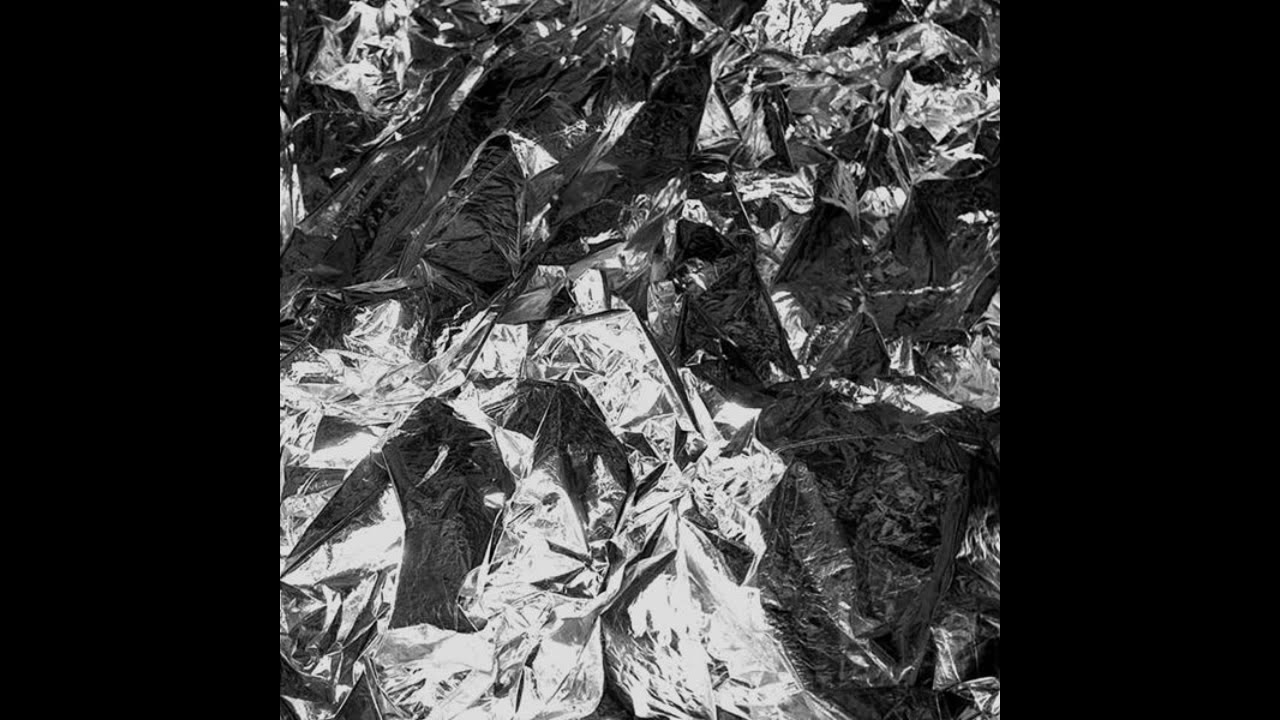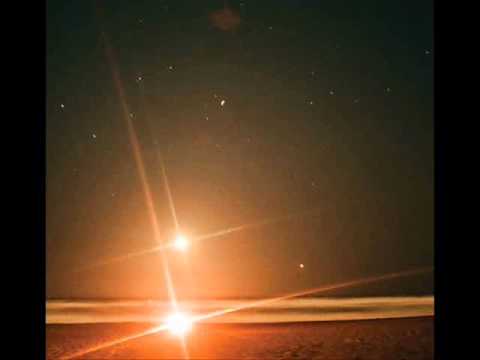Photo by Anthony Masters
With their latest album V on Thrill Jockey, the San Francisco Bay Area duo Barn Owl, consisting of Evan Caminiti and Jon Porras, continue to explore the possibilities of extreme sound in their own particular vein, a form of overwhelming affect as beauty.
Having made their name as one of many bands taken with the possibilities of guitar extremity via slabs of layered feedback and misty drones – something they honed to glorious, hypnotic extents on 2010’s Ancestral Star album – the duo have moved into working with their own particular electronic setup. The immediate results may appear the same, but possess a new grace balancing against the stark attractions of their past, and touch upon a whole range of influences and inspirations, reaching as much towards European artists such as Rhythm & Sound and Vladislav Delay as towards fellow Stateside drone/noise explorers.
Speaking to the Quietus while on their current European tour, both Porras and Caminiti were as engaged in the moment as they’ve always been, while looking forward to what possibilities might be next.
So at this point, with a number of formal releases now under your belt, what do you see as the through line between all the albums you’ve released? Is there one particular theme that carries through everything to your ears, or does it always mutate and change?
Evan Caminiti: I think we’ve touched on variations of a core aesthetic. I personally enjoy listening to artists that change over time, and think it’s exciting to challenge myself by learning new instruments and trying new techniques. We’re currently on tour and it’s our first major outing not playing guitars. A friend and musician I really respect who we’ve shared bills with for years told us "it still sounds just like Barn Owl", and I think the same. We’re focusing more on sound design rather than live guitar playing, because it’s inspiring and offers so many possibilities. I’m playing a modular synthesiser now and it allows for such flexible sound design, so I can have guitar esque sounds patched simultaneously with hand drum sounds, bass… the possibilities just really open up. A lot of my favorite musicians- people like Keiji Haino and Richard Youngs – can move seamlessly between instruments and imbue their music with their personal essence. I really love that. Not a bad thing to aspire to.
Jon Porras: Our collaborative chemistry and our writing process have stayed consistent over the years – pulling moments that unfold intuitively out of improv and solidifying those parts within fluid structure. We’ve always tried to bring a physical aspect to our music, designing sounds and atmospheres that gradually build and become immersive. Occupying a large frequency range helps do this – deep low end, blurred midrange melodies, fuzz and haze hovering above. It’s been refreshing to build these atmospheres with synths – I think it was important for us to develop a new dimension to our music. Also, we’ve always played within a modal framework, choosing one key per song and creating drama by deviating above or below the root note. We shoot to create big shifts in atmosphere with subtle changes in note and texture.
In the past I’ve described your approach as getting close to ‘black walls of sound’ – but this seemed more like a crushing serenity on V, like it was outer-reaches space rock where the void was literal and sat on your head a bit, though not all the time. Was this the result of a conscious new focusing?
EC: There was definitely a desire to experiment with new instrumentation and recording techniques. I view V as not having anything to do with "rock" at all. I wanted to take things to the outer reaches. We used some tools of rock like fuzz and tube amps, but would use them to produce crunching noises and reverb slaps then manipulate the recordings – slowed them down, reversed them, pulled them apart. We’ve always been interested in the contrast of extremely dense walls of sound, and very sparse, spacious passages. There is a major focus on rhythm with V, which lends itself to a more spacious mix.
JP: That’s great you picked up on that, because people have described the new album as bleak. There are dark moments, but we tried to balance them with euphoric passages and more radiant feelings. I think it’s important to make the void as tangible as possible. Music seems like a great way to do this – to feel elevated as you let yourself be overwhelmed by sound. The same idea as a whirling dervish, using sound to reach beyond your everyday identity in an attempt to access some deeper self. Facilitating that release has always been a part of our musical practice and I think it manifests itself in a different way on V. A distant radiating orb rather than a black wall.
Every time I’ve seen you live has been different — is every actual show you put on distinctly different, consciously or not, or does it just seem like it?
EC: There is always a natural desire to push forward. It just feels right. For a tour we’ll work in a similar framework night to night, not doing something exactly the sam but allowing for improvisation within structured movements.
JP: We like to keep things fresh by changing sets often and experimenting with new tools. We’re the type of music nerds who are constantly looking for ways to enhance our process and keep things exciting.
Is improvisation always a constant core of your general approach, whether live or studio, or is that more an impression based on the experience in both arenas? Related to that, are there such things as crowd favorites/standbys that you now have, or are aware of from talking with listeners and fans?
EC: Yeah, improvisation is an important part of both. There’s nothing like that initial moment of inspiration that happens with improv. At the same time, our new record has some of our most refined compositions yet. The songs are pretty minimal but I’ve found there are subtleties that surface with many and/or deep listenings. As far as live shows, ‘The Darkest Night Since 1683’ was a live staple for awhile, people seemed to enjoy that, including the only stage diver ever at any Barn Owl show – in London a while ago. But we’ve said all we wanted to with the sludgy guitar thing for now. Besides, we can’t afford half as many amps as Sunn O))).
JP: Yes, improv sits at the core of our project. On past albums we were concerned with capturing improvisational nuances that happened live in the studio. For V we wanted to focus on sculpting stretches of improv in post-production, finding nuances that emerge from processing and manipulating. This was an idea borrowed from dub, which seems to blur the line between production and performance. Improv also lends itself well to reaching beyond, toward that devotional facet of music. Using technical skill and knowledge of your instrument to facilitate these deliberate accidents – the way Zen art can seem meticulous and haphazard all at once. That flow when imagination runs fluidly through your actions with no second thoughts or reservations – this can be magical and an immensely rewarding aspect of playing music.
As you both have solo and other collaborative careers as well, you’ve by default gained more of a sense of what makes Barn Owl distinct in comparison — is that easily put into words or is it ultimately hard to describe?
EC: Barn Owl is what happens when our minds join. I’d say it’s defined by Jon and I making music together.
JP: In my mind it’s simple. Barn Owl happens when Evan and I sit down and dive into music as a duo. The solo stuff occupies a different part of my imagination and in some ways exists in a more cerebral place. The Barn Owl material evolves very fluidly, as a result of us just hanging out and working.
You’ve worked with people like Tom Carter directly — who else would you enjoy doing performances or recordings with?
EC: We’ve collaborated in various forms with Jefre Cantu Ledesma. We did a five week European tour together 2 years ago and played together almost every night for that time period, including some improvisations on VPRO in Amsterdam that also included Lisa McGee. We had a really intense live collaboration with Stephen O’Malley on that same tour in Paris. In addition, we had the opportunity to work with Ellen Fullman, that was amazing. As far as people we’d like to work with now it’s hard to say. It would be great to work with someone coming from a totally different background than us. We’ve worked with so many American musicians with drone backgrounds; it would be great to go in the opposite direction.
JP: Sasu Ripatti, Yoshi Wada, Fujiko Nakaya, Moritz von Oswald.
Is there a sense of a clear American psych/drone/doom/however you want to phrase it tradition or community, or is it something more transcendent? Do European audiences expect something different from American audiences? Finally, what else is upcoming on your plate, collectively or individually?
EC: There is a strong tradition of West Coast experimentalism, from the San Francisco Tape music center to Pacific Northwest drone; I would say we’re aligned with the spirit of the individuals who just did their own thing with a certain West Coast mentality. It comes down to a group of friends bouncing ideas off of each other and supporting each other. Currently, there can be a sense of community but it also feels fragmented. I suppose you could say we’ve been making an effort to connect people in the Bay Area, most recently by curating a three-month series called Remote View at the Lab in San Francisco. We asked people like Austin Cesear and Oliver Vereker to play. They are great examples of really promising young producers who share influences with us but take it in a more obviously techno direction, so it’s exciting to unify seemingly different music.
Exciting possibilities lie in new forms of experimentation and combination, and the Bay Area needs this fresh energy. I think European audiences definitely expect something different than American audiences. What exactly, I’m not sure, but they are more open and curious. We can play relatively small European cities on weeknights and a lot of people will come out – a huge range of ages, too. This is not so much the case in America. Funding for the arts is a higher priority in Europe, even though it’s been shrinking in the last few years. I don’t want to speak too generally, because we’ve had a lot of great shows in the States; we just had a really nice show in New York.
Hopefully Barn Owl will be touring in some new places this year. Coming up next for me is the debut LP of my project Painted Caves on Shelter Press. It’s been years in the making, so I’m excited for that, it focuses on modular synthesis and tape processing.
JP: Hard to say, it seems these experimental currents run through music all around the world. There seems to be a new scene of electronic focused acts in the Bay Area, which I’m excited about – Oliver Vereker and Austin Cesear being two young dudes I’ve been impressed with. This might sound wrong, but I don’t really think of expectations when we sit down to write a new set. Honestly, this gives me anxiety just thinking about it. It’s more productive for me to focus on how to develop the ideas we’re excited about – focus on making the music as solid and complete as possible and hope that our enthusiasm is translated over to the audience.
Barn Owl’s V is out now via Thrill Jockey.




